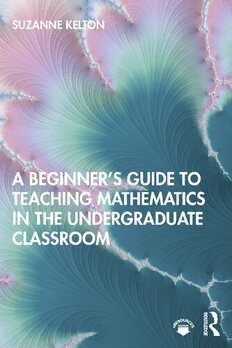Table Of ContentA Beginner’s Guide to
Teaching Mathematics
in the Undergraduate
Classroom
This practical, engaging book explores the fundamentals of pedagogy and
the unique challenges of teaching undergraduate mathematics not com-
monly addressed in most education literature.
Professor and mathematician, Suzanne Kelton offers a straightforward
framework for new faculty and graduate students to establish their individual
preferences for course policy and content exposition, while alerting them to
potential pitfalls. The book discusses the running of day-to-day class meetings
and offers specific strategies to improve learning and retention, as well as con-
crete examples and effective tools for class discussion that draw from a variety
of commonly taught undergraduate mathematics courses. Kelton also offers
readers a structured approach to evaluating and honing their own teaching
skills, as well as utilizing peer and student evaluations.
Offering an engaging and clearly written approach designed specifically for
mathematicians, A Beginner’s Guide to Teaching Mathematics in the Undergradu-
ate Classroom offers an artful introduction to teaching undergraduate math-
ematics in universities and community colleges. This text will be useful for
new instructors, faculty, and graduate teaching assistants alike.
Suzanne Kelton is Associate Professor of Mathematics at Assumption Uni-
versity in Worcester, MA. She received her Ph.D. in Mathematics at the Uni-
versity of Virginia and has taught mathematics to learners across a range of
universities and colleges.
A Beginner’s Guide to
Teaching Mathematics
in the Undergraduate
Classroom
SUZANNE KELTON
First published 2021
by Routledge
52 Vanderbilt Avenue, New York, NY 10017
and by Routledge
2 Park Square, Milton Park, Abingdon, Oxon, OX14 4RN
Routledge is an imprint of the Taylor & Francis Group, an informa business
© 2021 Taylor & Francis
The right of Suzanne Kelton to be identified as author of this work has been
asserted by her in accordance with sections 77 and 78 of the Copyright,
Designs and Patents Act 1988.
All rights reserved. No part of this book may be reprinted or reproduced or
utilised in any form or by any electronic, mechanical, or other means, now
known or hereafter invented, including photocopying and recording, or in
any information storage or retrieval system, without permission in writing
from the publishers.
Trademark notice: Product or corporate names may be trademarks or
registered trademarks, and are used only for identification and explanation
without intent to infringe.
Library of Congress Cataloging-in-Publication Data
Names: Kelton, Suzanne, author.
Title: A beginner’s guide to teaching mathematics in the undergraduate
classroom / Suzanne Kelton.
Description: New York : Routledge, 2021. | Includes bibliographical
references and index.
Identifiers: LCCN 2020029011 | ISBN 9780367429010 (hardback) |
ISBN 9780367429027 (paperback) | ISBN 9781003000044 (ebook)
Subjects: LCSH: Mathematics–Study and teaching (Higher) | Mathematics.
Classification: LCC QA11.2 .K46 2021 | DDC 510.71/1–dc23
LC record available at https://lccn.loc.gov/2020029011
ISBN: 978-0-367-42901-0 (hbk)
ISBN: 978-0-367-42902-7 (pbk)
ISBN: 978-1-003-00004-4 (ebk)
Typeset in Avenir and Dante
by KnowledgeWorks Global Ltd.
Access the Support Material: www.routledge.com/9780367429027
To my husband, for his steadfast love and support.
To my son, for his positive outlook and
unrelenting belief in me.
To my daughter, for never letting me
forget what is truly important.
To Timothy, Alexander, & Rosabel
∼ my rock, my light, & my love ∼
Contents
Acknowledgements ix
Introduction 1
Course Overview One 6
A Note on Terminology 7
Determining Desired Learning Outcomes 7
Assessment 13
Determining a Beginning Classroom Strategy 15
Backward Design 15 s
t
n
Quick Glance: Terminology Overview 16 e
t
n
o
Course Policies, Philosophies, and Syllabi Two 17 C
Course Policies 18 vii
Syllabi 36
The Basics of the Classroom Three 47
The First Day of Class 47
Preparing for Class 53
During Class and Office Hours 63
After Class 85
Assessment Four 87
Fostering Academic Honesty with Assessment 88
Homework 90
Quizzes 90
Preparing Students to Take an Exam 92
Writing an Exam 97
The Exam Was Too Long! 100
Grading an Exam 102
Addressing Instances of Academic Dishonesty 106
Course Grades 107
Challenges and Opportunities within Commonly
Taught Courses Five 111
Discussion Sections 111
Algebra – Is It Too Late?! 113
Precalculus 115
Calculus I: Differential Calculus 126
Calculus II: Integral Calculus 134
Sophomore Calculus 150
Elementary Linear Algebra 152
Proof Courses 156
Upper-Level Courses 159
Growth through Evaluation and Education Six 161
Self-Evaluation 163
Peer Evaluations and Collaborations 170
Student Evaluations 173
s
nt Pedagogical Professional Development 178
e
t
n
Co Going beyond Traditional Lecture Seven 179
viii Preparing to Try Something New 179
Active Learning 181
Course Designs for Active Learning 188
Online Courses 194
A Final Note on Innovation 197
Conclusion 199
References 200
Index 205
Acknowledgements
This book would not exist if not for the support of my colleague, James M.
Lang. He saw potential in a scrappy little manuscript and offered the encour-
agement, advice, and guidance necessary to create the book before you.
Thank you, Jim, for helping me make this book a reality.
My colleague, Charles Brusard, was the one of first to read the early manu-
script and he urged me to pursue its publication. His ardent support was the
s
t
driving force to begin the long journey towards the current book. n
e
I extend my gratitude to Edward G. Dunne, who was Senior Editor of the m
e
American Mathematical Society (AMS) Book Program when I approached g
d
e
him in 2010 regarding the original manuscript. He generously pursued its wl
posting on the AMS website, which has been a great honor. o
n
k
Assumption University (then Assumption College) provided the sabbatical c
A
required to significantly expand and update the manuscript. Thank you to
x
the staff at the Assumption University library for their efforts in retrieving i
research articles on my behalf.
I offer my sincere appreciation to those who provided essential feedback
and invaluable suggestions for improvement through formal or informal
reviews, especially Rachel Arnold, Jessica A. de la Cruz, Eric M. Howe, Steven
Klee, and Fatemeh Mohammadi.
Special thanks to Tim Woodcock for reading countless revisions and
providing assurances throughout this lengthy project.

